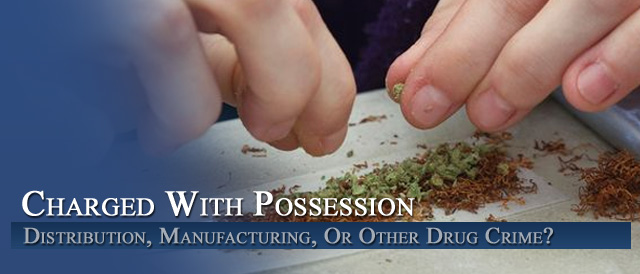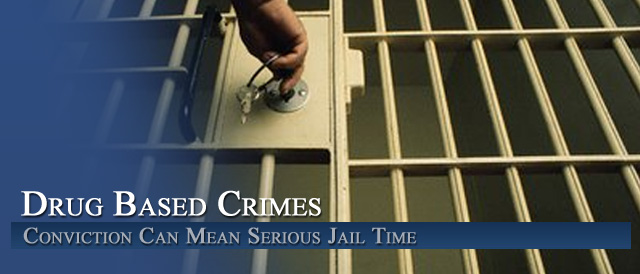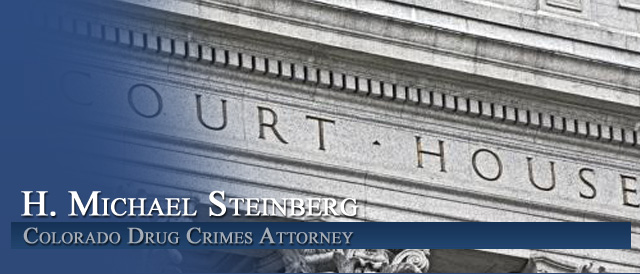




Colorado Criminal Law – Studies Helpful to Understanding Defenses Based Upon Prescription Drug -Medication-Induced Crimes | Colorado Criminal Defense Lawyer H. Michael Steinberg
by Colorado Criminal Defense Lawyer – H. Michael Steinberg
The following exhaustive article is a good starting point for understanding the role prescription drugs plays in the commissions of crimes. This is only a start – it is a collection of studies, thoughts and ideas – but it is a helpful start in recognizing the future for the defense of those charged with crimes who suffer from drug induced criminal acts.
The Insanity Defense
Insanity defenses are not only difficult but nearly impossible to successfully assert as complete defenses to the commission of crime. The insanity defense has been around for centuries. For example, as far back as in ancient Rome, legal codes distinguished between those who were insane, and thus not accountable for their wrongful conduct, and those who were sane, and thus held responsible for their actions.
The concept was introduced to English jurisprudence during the fourteenth century, when England’s King Edward recognized insanity as a complete defense to criminal charges. The English courts embraced the insanity defense, and it was well established by 1581.
The insanity defense is rooted in the fundamental idea that criminal behavior is punishable only when the actor is morally culpable or blameworthy.
It has been said that, under our system of jurisprudence, “a guilty mind must exist for a criminal act to occur.” As one commentator has explained: The idea that responsibility in the criminal law depends upon the presence of a guilty or “blameworthy” mind has ancient roots. All true crimes consist of two parts: the physical act, or actus reus, and the mental element of wishing, intending, or risking the harmful consequence of the act, called the mens rea. An act alone is neutral; it is by the state of mind moving the actor that we judge the conduct, for it is that wish, intent, or willingness to risk harm that attracts blame, and thus guilt.
A basic assumption of Anglo-American criminal law is that each person has the ability to distinguish and freedom to choose between lawful and unlawful conduct. It is this very capacity to distinguish and choose that provides the moral basis for holding a person criminally responsible for the person’s actions.
However, as a result of a mental disease, defect or disorder, some individuals may lack even a minimal capacity to make rational and voluntary choices. This absence of the ability to distinguish rationally between lawful and unlawful conduct and make voluntary choices is considered to eliminate the moral authority for imposing criminal sanctions. As the court in Holloway v. United States succinctly stated: “Our collective conscience does not allow punishment where it cannot impose blame.”
Insanity Tests – The M’Naghten Rule
In response to the famous M’Naghten case decided in 1843, the English judiciary established a standard for determining whether a person is insane. This standard, known as the M’Naghten rule, had become the generally accepted legal standard in the United States by 1851. The concept of insanity under M’Naghten is based solely upon cognitive disability.
Thus, under this rule, a person is insane if, at the time of the offense, the person was laboring under such a defect of reason, as a result of a disease of the mind, that the person did not know either:
(1) The nature and quality of the act the person was committing;
or
(2) That what the person was doing was wrong.
The Role of Substance Abuse in Mental Illness and the Commission of Crime
Substance abuse continues to rise and is responsible for, or associated with, a number of ills that plague our society, including crime, child and spouse abuse, prostitution, driving under the influence offenses, unemployment, gang activities and truancy. Many even in the law enforcement community, as well as others, believe that this increasing substance abuse is reflected in rising crime rates.
Studies show a significant correlation between crime and substance abuse, revealing that a substantial percentage of persons arrested for serious non drug crimes test positive for drug use or alcohol at the time of the offense.
It is recognized that, in some instances, the habitual long-term use of intoxicants can result in permanent mental disorders that are symptomatically and organically similar to mental disorders caused by brain disease.
Increased awareness of antidepressant medications to cause a paradoxical increase in depression, and in some cases, suicidal and homicide ideation.
Prescription medications that may cause or worsen anxiety, agitation, irritability, aggression, hostility, emotional blunting and dis-inhibition. These medications can induce or increase feelings that may lead to self-directed or outwardly directed violence, especially in a pre-disposed individual.
Recent years have seen increased concern about suicidality induced by prescription medications.
Suicidality and violence are closely connected clinically and often occur in the same individual at the same or at different times. This known clinical phenomenon is reflected in the frequent use of the phrase ‘violence toward self or others’.”
Antidepresants could explain the rash of incomprehensible violence
Harvard Medical School psychiatrist Joseph Glenmullen, author of Prozac Backlash, says antidepressants could explain the rash of school shootings and mass-suicides over the last decade. People who take antidepressants, he said, could “become very distraught….They feel like jumping out of their skin. The irritability and impulsivity can make people suicidal or homicidal.”
Robert Whitaker, author of Mad in America: Bad Science, Bad Medicine, and the Enduring Mistreatment of the Mentally Ill , researched violence and psychiatric drugs and determined, “Although the public may think that ‘crazy’ people are likely to behave in violent ways,” this is not true of ‘mental patients’ prior to the introduction of neuroleptics [nerve seizing antipsychotics]. Before 1955, four studies found that patients discharged from mental hospitals committed crimes at either the same or a lower rate than the general population. However, after the release of drugs like Thorazine [Largactil] in 1954 “eight studies conducted from 1965.
to 1979 determined that discharged patients were being arrested at rates that exceeded those of the general population…. Akathisia [extreme drug-induced restlessness which can cause assaultive, violent behaviour] was also clearly a contributing factor.”
The International Coalition for Drug Awareness compiled a record of more than 950 acts of violence over an eight-year period, committed by people of all ages taking Selective Serotonin Reuptake Inhibitor (SSRI) antidepressants. This includes 362 murders; 45 attempted murders; over 100 acts of violence and assault, including 13 school shootings; 5 bomb threats or bombings; 24 acts of arson; 21 robberies; 3 pilots who crashed their planes; and more than 350 suicides and suicide attempts.
The rise in senseless violence, especially evident in school shootings in the United States and elsewhere reflect the dramatic increase in antidepressant and antipsychotic usage in the community. Since 1988—a year after Prozac was approved for adult use in the United States—there have been 46 incidents of school violence involving 48 children and adolescents in that country. Of these, 38% (18) were reported in media, websites or books to be taking psychiatric drugs or were withdrawing from them at the time of their shooting spree. The relationship of psychiatric drugs in the remaining incidents of violence has not been publicly disclosed or the person’s records are sealed.
Of the 18 children and adolescents who committed acts of violence on psychiatric drugs, 9 were taking antidepressants, 5 were taking the stimulants Ritalin or Dexedrine, 1 was taking a tranquilliser and 3 took psychiatric drugs (specifics unknown). The 18 students, aged between 11 and 19, killed 47 people and wounded 104.
In May 2002, the U.S. Secret Service and Department of Education report on prevention of school attacks in the United States reviewed 37 incidents of targeted school shootings and school attacks between 1974 and June 2000—an average of 1.4 shootings per year. In comparison, the number of incidents over 18 years since 1988 was 2.5 per year—almost double.
Between 1995 and 1999, the use of antidepressants in the United States increased 151% in the 7-12 age group.11 The Journal of American Academy of Child and Adolescent Psychiatry reported a 500% increase in those 18 years of age and younger taking antidepressants between 1987 and 2002.12 Between 1990 and 2005, there was a more than 380% increase in the paediatric use of stimulants that the FDA warned in 2006 could cause psychosis, mania and aggression.
Given the serious risk of violence these drugs cause, it is imperative that patients recommended to take these as well as their families be fully apprised of the side effects in order to make an informed decision. In fact, on June 30, 2006 an Alaskan Supreme Court ruling regarding enforced psychiatric drug use determined, “Given the nature and potentially devastating impact of psychotropic medications… we now similarly hold that the right to refuse to take psychotropic drugs is fundamental.”
Recognizing the risks of these drugs, the court stated: “Psychotropic drug affect the mind, behaviour, intellectual functions, perception, moods, and emotion and are known to cause a number of potentially devastating side effects…. Courts have observed that the likelihood [that psychotropic drugs will cause] at least some temporary side effects appears to be undisputed and many have noted that the drugs may—most infamously—cause Parkinsonian syndrome (disease of the nerves causing tremor, muscle weakness, shuffling walk) and tardive dyskinesia (tardive, late and dyskinesia, abnormal movement of muscles).”
Courts: Psychiatric drugs induce violent acts
Robert Whitaker reports, “Little could the public have suspected that the madman of its nightmares, who kills without warning and for no apparent reason, was not always driven by an evil within but rather by a popular medication.”
Courts in the United States have agreed:
In June 2001, a Wyoming jury awarded $8 million to the relatives of a man, Donald Schell, who went on a shooting rampage after taking the antidepressant Paxil (Aropax in Australia) and killing his wife, daughter, and his baby granddaughter. The jury determined that the drug was 80% responsible for inducing the killing spree.
Testifying in the Schell case was Harvard psychiatrist John Maltsberger who said that SSRI manufacturers should warn prescribing physicians—in particular family and primary care physicians—that SSRIs can cause some patients to experience akathisia and mania, which, he told the court, can induce violence and even suicide.
David Healy, M.D., director of the Sub-Department of Psychological Medicine at the University of Wales College of Medicine, testified that as early as 1989, SSRIs (including Paxil) could cause 1 in 4 healthy volunteers to exhibit moderate to severe agitation, which, he said, could lead to violent behavior.
Dr. Richard Kapit, a former FDA researcher who investigated Prozac, Paxil and Zoloft before the drugs were allowed on the U.S. market, also testified in another murder case linked to SSRIs that he always suspected in some patients the drugs could cause mania, a condition that can lead to violence. “In the psychiatric profession, antidepressants have always been thought to cause manic episodes,” Kapit said. “Now, we have hard data to back up what everyone sort of believed.” Kapit was referring to three reviews of clinical trial data provided by drug companies presented at a FDA hearing in September 2004 that showed some children and adolescents taking antidepressants may develop suicidal thoughts or actions because of the drugs.
Reports authored by Kapit repeatedly warned the FDA that fluoxetine’s (Prozac) stimulant effects could cause insomnia, nervousness, anorexia, and agitated depression. Clinically, agitated depression is an unstable condition that can lead to violence against self or others more frequently than a non-agitated depression.
There is also the risk of suicide. As early as 1991, reports of Prozac being linked to suicidal behaviour were reported to the Australian TGA. One report shows that a 41-year-old female taking Prozac, had abnormal thinking, was agitated and anxious and made a suicide attempt and had impulses to harm and stab herself. Adverse reaction reports for Prozac and Lovan show there have been 70 suicide attempts, suicidal ideation and completed suicides.
Contemporary reports include:
2006: A 16-year-old girl was admitted to hospital—”Patient made 2 suicide attempts since starting the drug, nil previous. Drug ceased.”
2006: A 50-year-old female experienced the following while on Prozac, “The patient became more depressed whilst taking Prozac. She wanted to throw herself off a train or bus, had difficulty sleeping, was pacing and restless, had voice hallucinations, would look in the mirror and see a different person, had murderous thoughts, stiff legs, was hot a lot, felt she was in a delirium, could not concentrate, was angry, had numbness in her hands and pins and needles in her body which occurs in akathisia. Ceased Prozac.”
Further evidence of drug-associated violence
On September 2004, Dr. Healy released further evidence that SSRIs could cause aggression and homicidal behaviour. In response, the British Healthcare Products Regulatory Authority advised that it had issued guidelines that children should not be given most SSRI antidepressants because of clinical trial data showing an increased rate of harmful outcomes, including hostility.
In September 2006, Dr. Healy and his colleagues raised questions again about the link between this class of drugs and violent behavior. Dr. Healy’s team looked specifically at Glaxo Smith Kline’s (GSK) Paxil and concluded the drug raises the risk of severe violence in people taking them. “We’ve got good evidence that the drugs can make people violent and you’d have to reason from that that there may be more episodes of violence,” Dr. Healy stated. The findings, which are based in part on clinical trial data GSK submitted to the UK’s Committee on Safety of Medicines Expert Working Group, appear in the journal Public Library of Science Medicine (PLoS).32 “I have no reason to think all of the drugs in the group don’t pose just as much risk,” he said. “We need all of the companies to put their data on this risk out there so we can have a look at it.”
Substantial evidence from SSRI clinical trials shows that these drugs can trigger agitation. Approximately 5% of patients on SSRIs in randomized trials drop out for agitation against 0.5% on placebo (dummy pill). Several reports published since 1990 have linked SSRI intake with the production of emotional blunting, detachment, or an amotivational syndrome, described in one report as the equivalent to a ‘chemical lobotomy.’
In his book Prozac Backlash, published in 2000, Harvard University psychiatrist Joseph Glenmullen documented cases in psychiatric journals and in his own practice of disturbing side effects linked to SSRIs. He found cases of hallucinations, psychoses, violence, and attempted suicide among patients who took these drugs. In August 2006, Dr. Glenmullen said he believed Paxil could cause homicidal episodes.
Psychiatrist Peter Breggin in a study of SSRIs, published in the International Journal of Risk & Safety in Medicine in 2003, said: “There are many reports and studies confirming that SSRI antidepressants can cause violence, suicide, mania and other forms of psychotic and bizarre behaviour.”36 The fact that drug regulatory agencies require SSRI packaging to include the warning of “anger, aggression, and violence indicates a concern that antidepressant reactions can pose a danger to others,”
Dr. Breggin stated further,
“From agitation and hostility to impulsivity and mania,” he warns, “antidepressant induced behaviours is identical to that of PCP, (psychedelic also known as angel dust)methamphetamine and cocaine—drugs known to cause aggression and violence.” l One of the former lead chemists at the U.S. National Institute of Health, whose work led to the development of many antidepressant drugs, first spoke out against the drugs in an interview in TIME magazine in 1997, stating: “I am alarmed at the monster that Johns Hopkins neuroscientist Solomon Snyder and I created when we discovered the simple binding assay for drug receptors 25 years ago.”
She told the Melbourne Age in 2002, that there is now an ‘epidemic’ of over-medication. “There’s this increasing violence in the culture where people are going ‘postal’ (berserk). Doesn’t anyone ask what’s causing that? You know, a woman drowns her five children—these kinds of things never happened before…. A common thread is that people are on some of these psychiatric drugs. They’re supposed to help people, but they actually cause violence. There’s scientific literature that supports that. But it gets kind of swept aside. There’s too much money in the drugs. Prozac alone nets $US13 million ($A23.8 million) a day. It nets it! It’s an unbelievable figure.”
Drug agency warnings
Since 2000, there have been 119 international warnings against psychiatric drugs, 94 of them by government agencies, including the Australian Therapeutic Goods Administration (TGA), U.S. Food and Drug Administration (FDA), The Irish Medicines Board (IMB), New Zealand’s Medicines Adverse Reactions Committee (Medsafe), British Healthcare Products Regulatory Authority, European Committee for Medicinal Products for Human Use (CHMP), Health Canada, and BGA (German Drug Regulatory Authority). A sample follows, while an Appendix shows specific warnings that the Australian and New Zealand drug regulatory agencies have issued during the past four years.
In October 2003, the TGA issued an Adverse Drug Reactions Bulletin to warn that the new antidepressant Mirtazapine (Remeron, Avanza and Mirtazon) had received reports of potential serious reactions such as convulsions and of blood disorder along with reports of anxiety, agitations, nightmares and hallucinations.
In November 2005, the FDA’s Safety Information and Adverse Event Reporting Program reported “homicidal ideation” as an adverse event of Efexor ER (extended release) antidepressant.41 In a 2004 advisory, it also warned that all SSRIs could cause anxiety, agitation, panic attacks, insomnia, irritability, hostility, impulsivity, akathisia (severe restlessness), hypomania and mania” in both, “psychiatric and non-psychiatric” conditions.
In the 2006 edition of Australia’s drug manual, MIMS (Monthly Index of Medical Specialities), under the “Precautions in Children and Adolescents” for Aropax (antidepressant), it warns that in clinical trials for this population, adverse events related to suicidality (suicide attempts, suicidal thoughts) and hostility (predominately aggression, oppositional behaviour and anger) were more frequently observed in patients treated with Aropax than with placebo. Side effects listed for Aropax include: psychosis, psychotic depression, agitation and hostility.
In February 2006, Health Canada approved a new warning label for Paxil that read, in part: “A small number of patients taking drugs of this type may feel worse instead of better. For example, they may experience unusual feelings of agitation, hostility or anxiety, or have impulsive or disturbing thoughts, such as thoughts of self-harm or harm to others.”
As of August 2007, adverse drug reaction reports to the Australian TGA cited antidepressants as the sole suspected drug in 25 incidents of homicidal ideation, 176 reports of aggression, 136 suicide attempts and another 140 for suicidal ideation. Reports to the TGA linked to antipsychotics include: 26 reports for homicidal ideation/behaviour, 207 for aggression and 74 for suicidal behaviour. That is 51 incidents of homicidal ideation between the two classes of drugs and, as experts say only about only one percent of adverse reactions are reported, the number of homicidal reactions could be as high as 5,100.
Some of the incidents of homicidal behavior detailed include:
2006: A 25-year-old girl on the antipsychotic Seroquel had the following adverse reaction: “The patient experienced homicidal ideation, suicidal ideation, a suicide attempt, auditory hallucinations, akathisia. She found herself at her parent’s house carrying a knife with the intention to kill them.”
2006: A 53-year-old woman tried to kill herself and her children and was quoted in thereport as saying, “I never did that before I had the Efexor.”
2006: A 35-year-old male who had suicidal and homicidal ideation was described in the adverse reaction report as, “The patient experienced disassociation and murdered his wife whilst on Prozac.”
2005: An 18-year-old girl experienced aggression and homicidal ideation while taking the antidepressant Avanza, and was described in the report as experiencing “outbursts of violence against her boyfriend, smashed furniture and could not sleep… she experienced aggression and homicidal ideation— ‘cut him up and feed him to the pigs.’ “
2004: A male of unknown age taking the antidepressant Efexor and the antipsychotic Risperdal had “violent thoughts of ‘wanting to kill my parents’ which led to being placed under police arrest.” He did not have a history of violence according to the TGA report.
2000: A 25 year old taking the antipsychotic Zyprexa was aggressive, which was described in the report as “attacking and stabbing (hostility).”
Cases of drug-induced violence
Psychiatrists have known for years that psychotropic drugs induce psychotic and violent reactions as the sample of studies below show:
The Journal of Nervous and Mental Disease in 1988 found that many persons who had no history of violence prior to being placed on a neuroleptic, “were significantly more violent on haloperidol [Haldol].” In this study, the authors linked the marked increase in violence to “akathisia,” the negative reaction that was described as being frequently associated with taking major tranquillisers. Haldol, along with Mellaril, Stelazine and Thorazine were the four most widely used major neuroleptics before the atypical (new) drugs came on the market in the 1990s.
A 1990 study determined that 50% of all fights on a psychiatric ward could be tied to akathisia. Another study concluded that moderate-to-high doses of one major tranquilliser made half of the patients markedly more aggressive. Patients described “violent urges to assault anyone near.”
One 39-year-old man—after a haloperidol injection made him feel like he was “falling apart, that… all the bones in his body were broken,”—bludgeoned his mother with a hammer, an act he later found incomprehensible. Another 35-year-old man, asked why he had stabbed a grocer he had known for some time, said he did it to get the drug-induced pain out of his head: “The only reason I knifed the guy was Haldol messed me up. Prolixin [antipsychotic] makes me want to kill, too.”
The murderous explosion of a 23-year-old man, detailed in the Journal of Forensic Psychiatry, was perhaps the most chilling example of all. After his wife left him, he became distraught and was brought to an emergency room by the police. He had been briefly hospitalized a number of times before, and he warned the staff that he reacted badly to haloperidol. In spite of his protest, he was injected with the drug, and he quickly exploded in rage. He ran from the emergency room, tore off his clothes in a nearby park, and started attacking everyone he saw.
Over the course of 45 minutes, he tried to rape a woman walking in the park, broke into a house and beat an eighty-one-year-old woman to a pulp, fought with a policeman and then escaped, stabbed two more women, and was then at last subdued by a gang of eight police.
According to a study on a minor tranquillizer, “Extreme anger and hostile behavior emerged in eight of the 80 patients treated” with the drug. One woman who had no history of violence before taking the tranquillizer “erupted with screams on the fourth day, and held a steak knife to her mother’s throat for several minutes.”
In 1995, nine Australian psychiatrists reported that patients had slashed themselves or become preoccupied with violence while taking SSRI antidepressants. “I didn’t want to die, I just felt like tearing my flesh to pieces,” one patient told the psychiatrists.
Thousands of cases exist in which the person was in psychiatric hands before the crime. The following are but a few representative examples.
June 2001: In Japan, Mamoru Takuma stabbed to death eight schoolchildren and injuring 15 others in a frenzied knife attack while under the influence of tranquillizers.
14 June 2002: In Australia, Mohamud Hassan stabbed and killed a man. Hassan was first prescribed antipsychotic medication in February 2002. According to court documents he stopped taking antipsychotic medication on the day of the stabbing.
27 December 2002: Michigan resident Christopher Bernaiche opened fire in a bar, killing two men and wounding three others. Bernaiche had been taking an antidepressant for nearly two months and the dosage was doubled five days before the shootings.
29 June 2003: Irvine, California grocery store worker Joseph Parker killed two co-workers and injured three other people with a sword before being gunned down by police. Mr. Parker had been in psychiatric treatment and hospitalised at least twice. Three different bottles of psychiatric prescriptions including a mood stabilizer, a tranquilliser and an antipsychotic were found in his possession.
l 8 July 2003: Doug Williams gunned down 14 co-workers, killing six, at a Lockheed Martin aircraft parts plant in Meridian, Mississippi, before turning the gun on himself. He was using two antidepressants and had undergone an anger management program at a local mental health facility.
24 Nov. 2004: Former New York corrections officer Everett George shot and killed his 12-year-old son, then turned the gun on his baby daughter, fatally shooting her while she sat in her high chair. Afterwards he attempted suicide by downing several antidepressants.
According to Mr. Everett’s girlfriend he was taking six different prescriptions at the time including an antidepressant.
Withdrawal effects
Psychiatrists misleadingly argue that if patients, who dislike the side effects of their medication, stop taking it resulting in their ‘untreated’ mental disorder causing them to become violent.
However, the violence is most often caused by withdrawal from these drugs. In 1996, the National Preferred Medicines Centre Inc. of New Zealand issued a report on “Acute drug withdrawal”, which stated that withdrawal from psychoactive drugs can cause: 1) rebound effects that exacerbate previous symptoms of a disease, and 2) new symptoms unrelated to the original condition and unfamiliar to the patient.
In August 2005, the TGA published an Adverse Drug Reactions Bulletin reporting a review of SSRIs and evidence supporting an association between SSRI use and “new onset suicidality” in adults developing shortly after commencing the drugs or after an increase in dosage that could cause akathisia, agitation, nervousness and anxiety. Similar symptoms could occur during withdrawal.
In Lancet, the British medical journal, Dr. Miki Bloch reported patients who became suicidal and homicidal after stopping an antidepressant, with one man having thoughts of harming “his own children.”
In fact, studies also show that when patients stop taking these drugs, they improve. Psychiatrists cannot predict or cure violence By their own admission psychiatrists cannot predict dangerousness and often release violent patients claiming that they are not a threat to others or after granting them privileges that lessen security procedures in place for them.
In 1993, Angel Coro easily walked out of Rochester Psychiatric Centre, despite a long criminal and violent history with previous admissions to Rochester and a Buffalo psychiatric centre. At the time of his escape, Rochester staff had granted Mr. Coro grounds privileges, so that he could freely walk around. While escaped, Coro stabbed a 6-year-old girl, Colete Lopez, who was riding the subway in Manhattan with her mother.
In 1998 in Western Australia, a patient was seen by a psychiatrist after being referred to him because he was having acute hallucinations, feeling depressed, had suicidal thoughts and some features of mania, inattention, and flight of ideas. The patient was on Ritalin for ‘ADD.’ The psychiatrist saw the patient on January 8 and then went on holidays the following Sunday without a proper management plan in place for observation and supervision. On the January 17, the patient beat and killed his mother’s de facto husband.
In April 2003, a Superior Court jury in Santa Clara County, California ruled that psychiatrist Cecil Bradley was civilly liable for failing to prevent a patient’s violent crime after the patient told him repeatedly that he wanted to hurt others with his vehicle.
Eventually the patient drove his truck up on a sidewalk killing one man and injuring another. Dr. Bradley was ordered to pay $8.6 million to the surviving victim.
In December 2006 in NSW, Jayant Singh who had been in a psychiatric institution since July 2006 was released into the community. At the time of discharge, a risk assessment estimated that Singh was at low risk of harm to himself or others. Three days after he was released he allegedly slashed the throat of a baby with a meat cleaver and was charged with the baby’s murder.
A diagnostic system re-defines criminality
It would be easy to blame the ‘treatments’ alone for incidents of violence. Yet underneath these is an invented diagnostic system, the American Psychiatric Association’s (APA) Diagnostic and Statistical Manual of Mental Disorders IV (DSM) that is the main psychiatric manual used in Australia, and excuses criminal culpability and responsibility.
Canadian psychologist Tana Dineen reports, “Unlike medical diagnoses that convey a probable cause, appropriate treatment and likely prognosis, the disorders listed in DSMIV are terms arrived at through peer consensus”—literally, a vote by American Psychiatric
According to the DSM-IV, itself, “When the DSM-IV categories, criteria, and textual descriptions are employed for forensic purposes, there are significant risks that diagnostic information will be misused and misunderstood.” And it is “not sufficient to establish the existence for legal purposes of a ‘mental disorder,’ ‘mental disability,’ ‘mental disease,’ or ‘mental defect,’” in relation to competency, criminal responsibility or disability.
An American Psychiatric Association’s task force admitted in its 1979 Brief Amicus Curiae to the U.S. Supreme Court that psychiatrists could not predict dangerousness:
“It has been noted that ‘dangerousness’ is neither a psychiatric nor a medical diagnosis, but involves issues of legal judgment and definition, as well as issues of social policy. Psychiatric expertise in the prediction of ‘dangerousness’ is not established and clinicians should avoid ‘conclusory judgments in this regard.”
In response, the Supreme Court rendered the opinion that “the professional literature uniformly establishes that such predictions are fundamentally of very low reliability, and that psychiatric testimony and expertise are irrelevant to such predictions. In view of these findings, psychiatric testimony on the issue of future criminal behaviour only distorts the fact-finding process.”
In 2002, Kimio Moriyama, vice president of the Japanese Psychiatrists’ Association further admitted, “… [I]t is impossible for [psychiatric] science to tell whether someone has a high potential to repeat an offence.”
On March 28, 2007, Judge Helen O’Sullivan from Queensland labelled ‘psych reports’ a waste of time and described the author of one report for a repeat child sex offender as living in ‘fairyland’. On 29 January 2007, a lawyer requested an adjournment to have his client, a sex offender assessed, to which Judge O’Sullivan replied, “I am not very interested in psych reports, I think they are a total waste of time. What’s a psych report going to tell me? I think there are thousands of dollars going straight down the gurgler and the psychologists are tickled pink with us because we are abdicating our responsibility.”
The disorders contained in the DSM-IV are arrived at by consensus, not by scientific criteria and are most often influenced by the pharmaceutical industry. A study published in the April 2006 edition of Psychotherapy and Psychosomatics determined that 56% of the psychiatrists who determined which “mental disorders” were to be included in the fourth edition of DSM were drug-company funded. Lisa Cosgrove, a psychologist from the University of Massachusetts and Sheldon Krimsky, a Tuft University professor, conducted the study, entitled, “Financial Ties between DSM-IV Panel Members and the Pharmaceutical Industry.” It documented how pharmaceutical companies who manufacture drugs for mental disorders funded psychiatrists who defined the disorders for the manual. One hundred percent of the ‘experts’ on DSM-IV panels overseeing so-called ‘mood disorders’ (which includes depression) and ‘schizophrenia/ psychotic disorders’ were financially involved with drug companies. These are the largest categories of psychiatric drugs in the world: 2004 sales of $20.3 billion for antidepressants and $14.4 billion for antipsychotic drugs alone.
While creating violence with their treatments, those psychiatrists also undermine a person’s personal responsibility and the criminal justice system with the use of their ‘insanity defence’ that is based on an unscientific document: the DSM. On the surface, the idea of psychiatric drugs creating hostility and violence may not make sense. After all they are supposed to make people calm and quiet. But the reality is that they can and do create such adverse effects.
Not everyone who takes a psychiatric drug commits an act of violence, but clearly some do. Psychiatric drugs do create violence – the evidence, only part of which is presented in this report, is overwhelming.
Other Articles of Interest:
- FAQ – Colorado Criminal Law – The Defense of Colorado Criminal Prescription Fraud Cases
- FAQ – Colorado Criminal Drug Crimes Laws and Defenses – The Defense of Voluntary Intoxication in Colorado
- Colorado Criminal Drug Crimes Criminal Defense – Drug Conspiracy Charges and Understanding Colorado Prescription Drug Crimes Laws
- Colorado Criminal Law – Involuntary Commitments – 72 Hour Holds And Involuntary Medication
- Colorado Drug Crimes – Attempt To Obtain A Controlled Substance By Fraud Or Deceit – 18-18-415 and Doctor Patient Privilege












